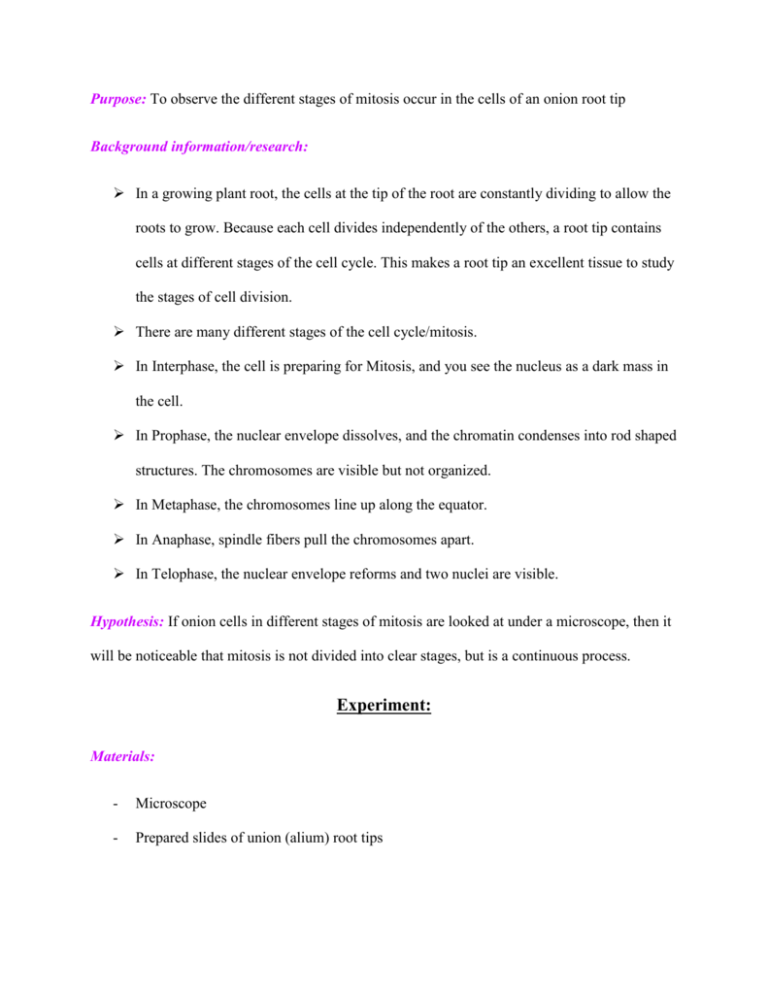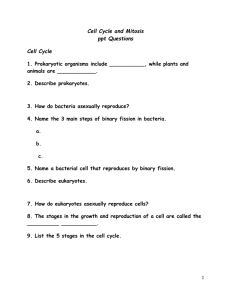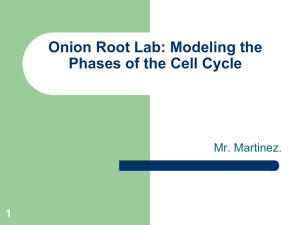File
advertisement

Purpose: To observe the different stages of mitosis occur in the cells of an onion root tip Background information/research: In a growing plant root, the cells at the tip of the root are constantly dividing to allow the roots to grow. Because each cell divides independently of the others, a root tip contains cells at different stages of the cell cycle. This makes a root tip an excellent tissue to study the stages of cell division. There are many different stages of the cell cycle/mitosis. In Interphase, the cell is preparing for Mitosis, and you see the nucleus as a dark mass in the cell. In Prophase, the nuclear envelope dissolves, and the chromatin condenses into rod shaped structures. The chromosomes are visible but not organized. In Metaphase, the chromosomes line up along the equator. In Anaphase, spindle fibers pull the chromosomes apart. In Telophase, the nuclear envelope reforms and two nuclei are visible. Hypothesis: If onion cells in different stages of mitosis are looked at under a microscope, then it will be noticeable that mitosis is not divided into clear stages, but is a continuous process. Experiment: Materials: - Microscope - Prepared slides of union (alium) root tips Procedure: 1. Get one microscope for your lab group and cary it to your lab desk with two hands. Make sure that the low power objective is in position and that the diaphragm is open to the widest setting 2. Obtain a prepared slid of an onion root tip (there will be three root tips on the slide). Hold the slide up to the light to see the pointed ends of the root sections. This is the root tip where the cells are actively dividing. (The root tips are freshly sliced into thin sections, then preserved when the slide was prepared.) 3. Place the slide on the microscope stage with the root tips pointing away from you. Using the low power objective to find a root tip, and focus it with the coarse adjustment knob until it is clearly visible. Just above the root “cap” is a region that contains many new small cells. The larger cells in this region were in the process of dividing when the slide was made. These are the cells that you will be observing. Center the image, then switch to high power. 4. Observe the box like cells that are in arranged rows. The chromosomes of the cells have been stained to make them easily visible. Select one cell whose chromosomes are clearly visible. (if you need to change the focus when using high power, make sure to only use the fine adjustment knob. 5. Sketch the cell that you selected in first box. 6. Look around at the cells again. Select four other cells whose internal appearances are different from each other and the first one that you sketched. Sketch them in the remaining boxes. 7. As you look at the cells of the root tip, you may notice that some cells seem to be empty inside (There is no dark nucleus or visible chromosomes). This is because these cells are three dimensional, but we are looking at just thin slices of them. (If you slice a hardboiled egg at random, would you diffidently see the yolk in your slice? No.) We want to continue to look at the cells, but we will ignore anywhere we cannot see the genetic material (dark areas). 8. Looking along the rows of cells, identify what stage each cell is in. Use photos of the different stages as a guide. 9. Use the data table to record the number of cells you see in each of the stages. The easiest way to do this is for one person to look through the microscope, going along each row of cells. For each cell, say out loud what stage it appears to be in. Another student can make tally marks for each stage. Observations/Data/Results: Cells observed in the different stages through the high power objective lens: Stage of Cell Cycle Number of Cells in the Stage % of cells Interphase 36% Prophase 22% Metaphase 10% Anaphase 12% Telophase 20% Analysis of Data: The data shows us how long each of the stages are in relation to the others. If a stage is very short, then the cell will be finished with it quickly, and less will appear in that stage, and vice versa. For example, the data shows that most of the cells observed at the onion root tip were in the Interphase stage. Therefore, Interphase is most likely the longest step of the cell cycle. The least number of cells were found in Metaphase, showing that it is most likely the shortest. The term “most likely” is used instead of “definitely” because it is not always certain and clear what stage a cell is in. This is because mitosis is a continuous process, not a series of clearly difined steps. Answering questions related to the lab: 4) The onion plant began with a single cell. That cell had X number of chromosomes. (The exact number does not matter; we will just call that number X). How many chromosomes are in each of the cells you observed? (Give the answer in terms of X) How do you know? Each of the cells observed contained X chromosomes. This is because every cell (nonmutant) always contains the same number of chromosomes. During mitosis, the chromosomes are doubled, and then split, resulting in the same number of chromosomes for the two daughter cells as their parent had. 5) If this onion would reproduce sexually, it would need to produce sperm and/or eggs by the process of meiosis. After meiosis, how many chromosomes would be in each sex cell? In ach sex cell, there would be 1/2x chromosomes 6) If this onion would complete the process of sexual reproduction (fertilizing an egg cell) How many Chromosomes would be in zygotes that are produced (In terms of X)? In each zygote, there would be x chromosomes. Conclusion: The data and analysis supported my hypothesis that mitosis is a continuous process and not a series of steps. This is because some cells appeared to in the middle of Metaphase and Anaphase. The chromosomes where lined up, but not in a straight line, some had already started being pulled away from the equator of the cell. (It was later deemed that Anaphase was the best choice.) While this particular cell was one of the more obvious ones, many of the cells were hard to distinguish into certain phases. The most common “mixed” cells were in between interphase an prophase. The final data somewhat deviated from previous expectations. I believed that each of the stages would be represented by approximately the same amount of cells. For example, it seemed unlikely before the experiment that the preparation for mitosis (Interphase) would take any longer (and therefore have any more cells representing it) than the cell and its contents beginning to split (Telophase).The data showed, however, a shocking 16% difference between the two stages. I had several questions during the experiment. Two of these are: How many Chromosomes are in each cell? At what point in the cells life does it stop going through mitosis/the cell cycle? Is there a point in which a cell does not undergo any stage of mitosis? There is a sub phase of G1 called G0. At this point the cells do not develop further into the cell cycle, or make any preparations for cell division. Instead, the cells just continue on with life processes. This stage can last for a variety of times, sometimes for a few minutes, and sometimes for years. The cells can leave G0 with signals from other cells and other parts of the body. Citations: "THE CELL CYCLE." SparkNotes. SparkNotes, n.d. Web. 04 May 2014. Olsen, Ms. Observing Mitosis Lab. Apr.-May 2014. Lab sheet. Mader, Sylvia S. Biology. Boston: WCB/McGraw-Hill, 1998. Print.









